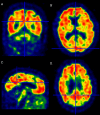Biparietal variant of Alzheimer's disease: a rare presentation of a common disease
- PMID: 25564588
- PMCID: PMC4289771
- DOI: 10.1136/bcr-2014-207011
Biparietal variant of Alzheimer's disease: a rare presentation of a common disease
Abstract
Alzheimer's disease (AD) is a clinically heterogeneous disease that may have atypical presentations with focal cortical syndromes and relatively preserved episodic memory. The posterior variant of AD has two subtypes: occipitotemporal, presenting with visuoperceptive impairment, and biparietal, presenting with visuospatial dysfunction and apraxia. We report a case of a 51-year-old woman with progressive limb apraxia and choreiform movements. Her neuropsychological evaluation was compatible with dementia, and revealed ideomotor and ideational limb apraxia, severe visuoconstructive ability impairment, dyscalculia and posterior aphasia. Workup excluded metabolic, infectious, inflammatory or neoplastic causes, and hereditary conditions as Huntington's disease and familial AD. Cerebrospinal fluid biomarkers revealed β-amyloid reduction and τ protein increase. Brain imaging showed marked biparietal atrophy and hypoperfusion, and widespread cortical β-amyloid deposition. Biparietal variant of AD was diagnosed and acetylcholinesterase inhibitor treatment induced clinical stabilisation. AD may present with atypical features and a high clinical suspicion is necessary for an early diagnosis.
2015 BMJ Publishing Group Ltd.
Figures




Similar articles
-
The Progressive Acalculia Presentation of Parietal Variant Alzheimer's Disease.J Alzheimers Dis. 2018;63(3):941-948. doi: 10.3233/JAD-180024. J Alzheimers Dis. 2018. PMID: 29710718 Free PMC article.
-
Progressive transcortical sensory aphasia and progressive ideational apraxia owing to temporoparietal cortical atrophy.BMC Neurol. 2015 Nov 11;15:231. doi: 10.1186/s12883-015-0490-2. BMC Neurol. 2015. PMID: 26559349 Free PMC article.
-
Typical and atypical appearance of early-onset Alzheimer's disease: A clinical, neuroimaging and neuropathological study.Neuropathology. 2017 Apr;37(2):150-173. doi: 10.1111/neup.12364. Epub 2017 Jan 17. Neuropathology. 2017. PMID: 28093855
-
Case Studies Illustrating Focal Alzheimer's, Fluent Aphasia, Late-Onset Memory Loss, and Rapid Dementia.Neurol Clin. 2016 Aug;34(3):699-716. doi: 10.1016/j.ncl.2016.04.008. Epub 2016 Jun 3. Neurol Clin. 2016. PMID: 27445249 Free PMC article. Review.
-
Focal cortical atrophy syndromes.Brain Cogn. 1996 Jul;31(2):188-229. doi: 10.1006/brcg.1996.0042. Brain Cogn. 1996. PMID: 8811996 Review.
Cited by
-
Posterior cortical atrophy: the value of neuroimaging in assessing memory loss.Quant Imaging Med Surg. 2017 Dec;7(6):736-739. doi: 10.21037/qims.2017.09.04. Quant Imaging Med Surg. 2017. PMID: 29312879 Free PMC article. No abstract available.
-
The Progressive Acalculia Presentation of Parietal Variant Alzheimer's Disease.J Alzheimers Dis. 2018;63(3):941-948. doi: 10.3233/JAD-180024. J Alzheimers Dis. 2018. PMID: 29710718 Free PMC article.
-
Can patients without early, prominent visual deficits still be diagnosed of posterior cortical atrophy?J Neurol Sci. 2016 Aug 15;367:26-31. doi: 10.1016/j.jns.2016.05.020. Epub 2016 May 13. J Neurol Sci. 2016. PMID: 27423559 Free PMC article.
References
Publication types
MeSH terms
Substances
LinkOut - more resources
Full Text Sources
Other Literature Sources
Medical
